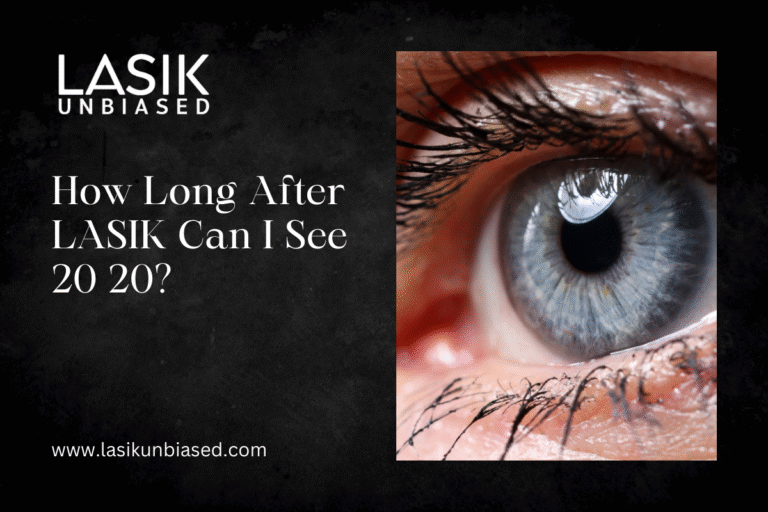Most LASIK patients begin to see significant improvements within 24 to 48 hours, but stable 20/20 vision can take several days to weeks to fully achieve.
Healing is progressive, and reaching your best visual clarity depends on factors like prescription strength, individual healing patterns, and strict adherence to aftercare.
Understanding the LASIK Recovery Timeline for 20/20 Vision
Laser-Assisted in Situ Keratomileusis (LASIK) is a leading refractive surgery aimed at correcting nearsightedness, farsightedness, and astigmatism. One of the most common questions patients ask before undergoing LASIK is: “When will I be able to see 20/20?” While LASIK offers rapid results, the journey to perfect vision varies for everyone.
What Happens Immediately After LASIK?
Your vision typically begins improving within a few hours after surgery. Some patients report a noticeable difference in clarity shortly after the procedure, though vision may still appear hazy or fluctuate during the initial healing phase.
In the first 24 hours:
- Vision often appears foggy or hazy.
- Mild discomfort, such as burning or itching, is normal.
- Sensitivity to light is common.
- Most surgeons advise resting and avoiding screen time.
Important: You should not expect to reach 20/20 vision immediately. While many patients do experience clear vision the next day, others may require several days to weeks to stabilise.
Typical 20/20 Vision Milestones After LASIK
Day 1 to Day 2: Early Visual Gains
- Significant clarity returns within 24 to 48 hours for most patients.
- At your follow-up exam (usually scheduled within 24 hours), your surgeon checks healing progress.
- Many patients are cleared to drive within 24 to 48 hours after LASIK, but only after passing a follow-up vision test confirming they meet legal driving standards.
Still, 20/20 vision may not yet be fully stable. Some blurriness, halos around lights, or light sensitivity may persist.
Week 1: Sharper, More Consistent Vision
- Visual fluctuations reduce significantly.
- Most patients function comfortably without glasses or contacts.
- You can resume work and daily activities, but avoid strenuous exercise or rubbing your eyes.
By this point, a large percentage of LASIK patients see 20/20 or close to it, but fine-tuning may continue.
Weeks 2 to 4: Vision Refines Further
- Your cornea continues healing.
- Vision becomes more consistent, with less dryness and irritation.
- Night vision improves, and side effects like glare usually decrease.
If you’re not yet at 20/20, don’t worry — gradual improvement is expected. This is especially true for those with high prescriptions.
1 to 3 Months: Final Visual Outcomes Take Shape
- For most patients, 20/20 vision stabilises by the three-month mark.
- You should attend all scheduled check-ups to ensure proper healing.
- Most mild visual irregularities, such as ghosting or slight blurriness, tend to improve significantly by this point, though some patients may experience longer-lasting symptoms depending on individual healing and other factors.
This is the timeframe where your long-term visual clarity becomes apparent.
Why Vision May Not Be 20/20 Right Away?
Prescription Severity Affects Speed of Clarity
- If you had a strong prescription (e.g., high myopia), your eyes may need more time to adjust post-surgery.
- Patients with mild to moderate prescriptions often reach 20/20 more quickly.
Individual Healing Response Varies
- Everyone’s eyes heal differently. Factors like corneal thickness, age, and baseline eye health play roles.
- Some people naturally recover faster than others.
Postoperative Dry Eye Is Common
- Temporary dry eye can cause blurred or unstable vision in the first weeks.
- Use prescribed lubricating drops to support comfort and clarity.
How to Support a Faster Path to 20/20 Vision?
Follow Postoperative Instructions Rigorously
Your surgeon provides a detailed recovery plan. Adhering to this is critical. It typically includes:
- Using antibiotic and anti-inflammatory drops as directed.
- Wearing eye protection when sleeping.
- Avoiding pools, hot tubs, and environments with dust or wind.
Avoid Eye Strain
- Limit screen time in the first few days.
- Take regular breaks if you work at a computer.
- Give your eyes the rest they need to heal optimally.
Stay Hydrated and Maintain Eye Moisture
- Use preservative-free artificial tears frequently, especially in dry climates or indoors with AC or heat.
- Drink plenty of water to support systemic hydration.
When to Expect Enhancements if 20/20 Isn’t Achieved?
Not Every Patient Reaches 20/20 Immediately — or at All
Although LASIK has a success rate of over 96%, not everyone will reach perfect vision without some residual refractive error.
You might still benefit significantly from LASIK, but may:
- Have minor vision fluctuations at night.
- Experience slightly blurred distance vision.
Enhancements Are Uncommon but Available
- Enhancements (also called touch-ups) are sometimes performed 3 to 6 months after the initial surgery.
- They are more common in patients with high prescriptions or age-related visual changes.
Your surgeon will make the determination of whether a secondary procedure is appropriate.
What Your Doctor Checks at Follow-Up Visits?
At follow-up appointments, your surgeon evaluates:
- Visual acuity (including whether 20/20 has been reached).
- Corneal healing status.
- Any symptoms like dryness, halos, or glare.
These assessments are essential in determining if you’re on track or need further treatment.
Realistic Expectations: Is 20/20 Vision Guaranteed?
No, 20/20 is not guaranteed for every patient. While LASIK is highly precise, final results depend on:
- Preoperative prescription strength.
- Eye anatomy (e.g., corneal curvature, thickness).
- Age and natural vision changes over time.
While LASIK reshapes the cornea to correct refractive errors, it does not prevent age-related changes like presbyopia, which may require additional vision correction methods.
If your goal is perfect vision without glasses for both distance and reading, your doctor may recommend additional strategies, like monovision LASIK or lens-based procedures.
Key Takeaways: When Will You See 20/20 After LASIK?
- The majority of patients observe significant visual improvement within one to two days.
- Stable 20/20 vision typically develops within 1 to 3 months.
- Some patients with stronger prescriptions or dry eyes may take longer.
- Following postoperative care instructions is vital to achieving optimal results.
Conclusion: Clarity Comes with Time and Care
Seeing 20/20 after LASIK is a journey, not just a moment. While dramatic improvements can happen quickly, your best visual outcome depends on proper healing and individualised factors. With careful aftercare, regular follow-ups, and patience, most patients achieve — and maintain — crisp, clear vision without glasses or contacts.
If you’re considering LASIK and wondering about your timeline to 20/20, consult with a board-certified refractive surgeon. They can evaluate your eyes and give you a realistic forecast based on your prescription and health.
Your journey to better vision starts with the right information — and the right expectations.


